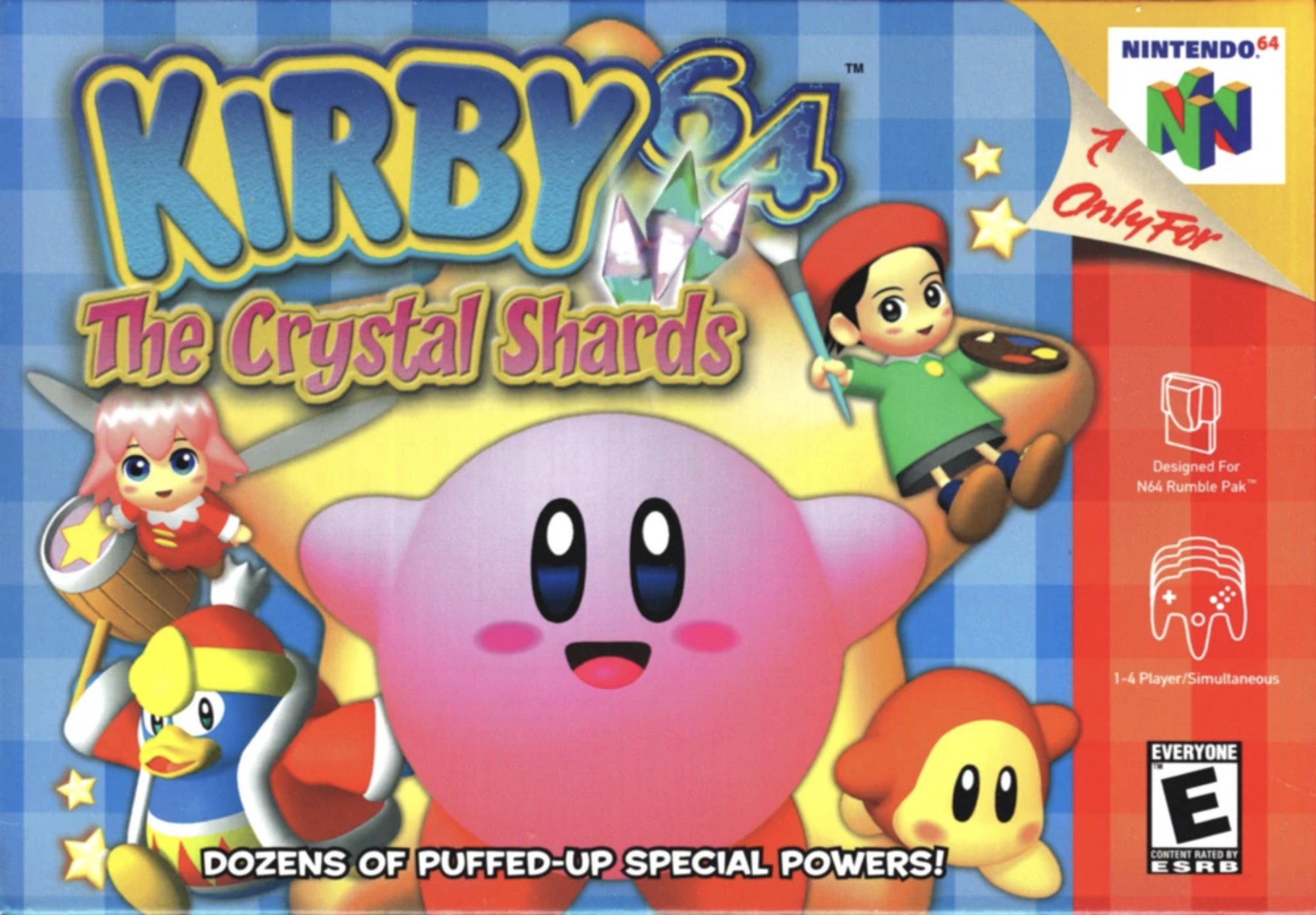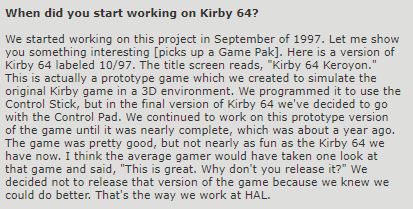Kirby 64 Keroyon (lost prototype build of Nintendo 64 platformer "Kirby 64: The Crystal Shards"; 1997): Difference between revisions
SouthBySouth (talk | contribs) No edit summary |
|||
| (3 intermediate revisions by 2 users not shown) | |||
| Line 5: | Line 5: | ||
|status=<span style="color:red;">'''Lost'''</span> | |status=<span style="color:red;">'''Lost'''</span> | ||
}} | }} | ||
''Kirby 64: The Crystal Shards'' was a platformer released on March 24th, 2000 for the Nintendo 64, developed by HAL Labratory and published by Nintendo. it was the last home console ''Kirby'' platforming game released until ''Kirby's Return to Dreamland'' in 2011. | ''Kirby 64: The Crystal Shards'' was a platformer released on March 24th, 2000 for the Nintendo 64, developed by HAL Labratory and published by Nintendo. it was the last home console ''Kirby'' platforming game released until ''Kirby's Return to Dreamland'' in 2011. The game was well received for the unique feature to combine copy abilities. | ||
==Prototype== | ==Prototype== | ||
During an interview conducted before the release of ''Kirby 64'', Takashi Saito showed the interviewer a cartridge containing an early prototype of the game.<ref>[https://web.archive.org/web/20030610004527/http://www.nintendo.com/games/gamepage/developerinfo.jsp?gameId=312 Archived Nintendo.com developer interview that mentions ''Kirby 64'''s prototype build.] Retrieved 10 Apr '22</ref> The cartridge holding the prototype had "10/97" written on it, likely dating the build to October of 1997; as ''Kirby 64'' began development in September of that year, that means that this build had been in development for only one month. ''' | During an interview conducted before the release of ''Kirby 64'', Takashi Saito showed the interviewer a cartridge containing an early prototype of the game.<ref>[https://web.archive.org/web/20030610004527/http://www.nintendo.com/games/gamepage/developerinfo.jsp?gameId=312 Archived Nintendo.com developer interview that mentions ''Kirby 64'''s prototype build.] Retrieved 10 Apr '22</ref> The cartridge holding the prototype had "10/97" written on it, likely dating the build to October of 1997; as ''Kirby 64'' began development in September of that year, that means that this build had been in development for only one month. '''The title screen shows the title "''Kirby 64'' Keroyon". It was created to see what it would be like if "''Kirby's Dream Land'' was made into a 3d Map"<ref>[https://www.nintendo.co.jp/nom/0003/madika/page02.html Original untranslated nintendo.co.jp interview, where Takashi explicitly mentions ''Kirby's Dream Land''.] Retrieved 13 Apr '22</ref>.''' It is unclear whether this prototype was in the style of the final game's 2.5D sidescrolling, or was a fully 3D environment similar to ''Super Mario 64''. | ||
They continued to work on this version of the game until it was nearly complete; however, they didn't release it because they believed they could do better. It is unknown whether the version was completely scrapped and they started over, or if he simply means that they kept developing and improving the version until it became the final released game. | They continued to work on this version of the game until it was nearly complete; however, they didn't release it because they believed they could do better. It is unknown whether the version was completely scrapped and they started over, or if he simply means that they kept developing and improving the version until it became the final released game. | ||
| Line 23: | Line 23: | ||
*[[Kirby Bowl 64 (lost unreleased Nintendo 64 prototype of "Kirby Air Ride" GameCube racing game; 1996)]] | *[[Kirby Bowl 64 (lost unreleased Nintendo 64 prototype of "Kirby Air Ride" GameCube racing game; 1996)]] | ||
*[[Kirby's Return to Dream Land (lost builds of cancelled predecessors to Wii action-platformer; 2005-2011)]] | *[[Kirby's Return to Dream Land (lost builds of cancelled predecessors to Wii action-platformer; 2005-2011)]] | ||
*[[Kirby Tilt 'n' Tumble 2/Roll-o-Rama (lost builds of cancelled GameCube action puzzle games; 2001-2002)]] | |||
==References== | ==References== | ||
Latest revision as of 18:27, 16 November 2022
Kirby 64: The Crystal Shards was a platformer released on March 24th, 2000 for the Nintendo 64, developed by HAL Labratory and published by Nintendo. it was the last home console Kirby platforming game released until Kirby's Return to Dreamland in 2011. The game was well received for the unique feature to combine copy abilities.
Prototype
During an interview conducted before the release of Kirby 64, Takashi Saito showed the interviewer a cartridge containing an early prototype of the game.[1] The cartridge holding the prototype had "10/97" written on it, likely dating the build to October of 1997; as Kirby 64 began development in September of that year, that means that this build had been in development for only one month. The title screen shows the title "Kirby 64 Keroyon". It was created to see what it would be like if "Kirby's Dream Land was made into a 3d Map"[2]. It is unclear whether this prototype was in the style of the final game's 2.5D sidescrolling, or was a fully 3D environment similar to Super Mario 64.
They continued to work on this version of the game until it was nearly complete; however, they didn't release it because they believed they could do better. It is unknown whether the version was completely scrapped and they started over, or if he simply means that they kept developing and improving the version until it became the final released game.
The prototype has not been seen or mentioned outside of this interview.
Gallery
See Also
- Kid Kirby (lost build of cancelled Super Nintendo game of action-platformer series; 1990s)
- Kirby's Air Ride (lost Nintendo 64 development build of "Kirby Air Ride" GameCube racing game; 1996)
- Kirby Bowl 64 (lost unreleased Nintendo 64 prototype of "Kirby Air Ride" GameCube racing game; 1996)
- Kirby's Return to Dream Land (lost builds of cancelled predecessors to Wii action-platformer; 2005-2011)
- Kirby Tilt 'n' Tumble 2/Roll-o-Rama (lost builds of cancelled GameCube action puzzle games; 2001-2002)

